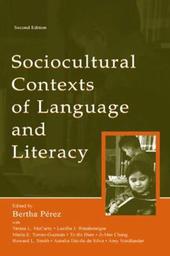
|
Socialcultural Contexts of Language and Literacy
Paperback
Main Details
| Title |
Socialcultural Contexts of Language and Literacy
|
| Authors and Contributors |
Edited by Bertha Paerez
|
|
Edited by Teresa L. McCarty
|
|
Edited by Lucille Watahomigie
|
|
Edited by Maria E. Torres-Guzman
|
|
Edited by To thi Dien
|
| Physical Properties |
| Format:Paperback | | Pages:420 | | Dimensions(mm): Height 229,Width 152 |
|
| Category/Genre | Usage and grammar guides
Literacy |
|---|
| ISBN/Barcode |
9780805843415
|
| Classifications | Dewey:418.0071 |
|---|
| Audience | |
|---|
| Edition |
2nd Revised edition
|
| Illustrations |
Illustrations
|
|
Publishing Details |
| Publisher |
Lawrence Erlbaum Associates Inc
|
| Imprint |
Lawrence Erlbaum Associates Inc
|
| Publication Date |
29 April 2004 |
| Publication Country |
United States
|
Description
Sociocultural Contexts of Language and Literacy, Second Edition engages prospective and in-service teachers in learning about linguistically and culturally diverse students, and in using this knowledge to enrich literacy learning in classrooms and communities. The text is grounded in current research and theory that integrate sociocultural and constructivist concepts and perspectives and provide a framework teachers can use to develop strategies for teaching reading, writing, and thinking to diverse students. The focus on English literacy development does not imply advocacy for "English only" or ESL as the primary mode of literacy instruction. Rather, the authors take the position that learners need to develop literacy in their native language and that the concepts and skills learned in developing the native language create a foundation of strength from which students can develop English literacy. Part I introduces relevant research and language learning theories. Part II provides research reviews and information about literacy learning within specific culturally and linguistically diverse communities. The chapters in Part III challenge the reader to view the multiple social, intellectual, cultural, and language differences children bring to the classroom as an opportunity for learning and building on the diversity among students. Activities and suggested readings at the end of each chapter involve readers in reflection, observation, meaning making, and the construction of application processes for their new understandings. New in the Second Edition: *updated research and theory on multilingual and second language literacy; *a focus on the interpretation of these research findings to make them useful for teachers and teacher educators in understanding and articulating the research bases for literacy practices; *attention to current intensely debated issues, such as standards, the phonics movement, and high-stakes testing; and *new activities and suggested readings.
|